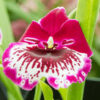# Discussing the Challenges of Growing Oncidium Orchids Today

Oncidium orchids, commonly known as “Dancing Lady Orchids,” are a captivating genus within the orchid family, admired for their unique shapes and vibrant colors. While their beauty makes them a favorite among plant enthusiasts, growing Oncidium orchids comes with its own set of challenges. This article explores the various hurdles faced by orchid growers today, including environmental factors, pest management, cultivation techniques, and the impact of climate change, while offering solutions and insights from experienced growers.
## Table of Contents
1. **Introduction**
– 1.1 Overview of Oncidium Orchids
– 1.2 The Appeal of Oncidium Orchids
2. **Environmental Challenges**
– 2.1 Temperature Control
– 2.2 Humidity Levels
– 2.3 Light Requirements
3. **Pest and Disease Management**
– 3.1 Common Pests Affecting Oncidium Orchids
– 3.2 Fungal and Bacterial Diseases
– 3.3 Prevention and Treatment Strategies
4. **Soil and Potting Challenges**
– 4.1 Choosing the Right Medium
– 4.2 Repotting Difficulties
– 4.3 Pot Selection and Drainage
5. **Watering Techniques**
– 5.1 Understanding Water Needs
– 5.2 Water Quality Issues
– 5.3 Scheduling and Techniques
6. **Fertilization and Nutritional Needs**
– 6.1 Identifying Nutritional Deficiencies
– 6.2 Choosing the Right Fertilizers
– 6.3 Timing and Application Methods
7. **Climate Change and Its Impact**
– 7.1 Effects of Global Warming
– 7.2 Changes in Growing Seasons
– 7.3 Adaptation Strategies
8. **The Importance of Education and Community**
– 8.1 Access to Resources
– 8.2 Community Support and Networking
– 8.3 Online Platforms for Learning
9. **Success Stories and Innovations**
– 9.1 Innovative Growing Techniques
– 9.2 Advances in Pest Management
– 9.3 Success Stories from Growers
10. **Conclusion**
– 10.1 The Resilience of Orchid Growers
– 10.2 Embracing the Challenges of Growing Oncidium Orchids
## 1. Introduction
### 1.1 Overview of Oncidium Orchids
Oncidium orchids are a diverse genus with over 200 species, characterized by their intricate blooms and varied colors. They are native to tropical and subtropical regions of Central and South America, making them popular among orchid enthusiasts for their unique appearance and relatively easy care requirements. However, despite their allure, growing Oncidium orchids presents several challenges that can deter even seasoned growers.
### 1.2 The Appeal of Oncidium Orchids
The aesthetic beauty of Oncidium orchids is undeniable, with their flowers resembling dancing ladies, hence the name “Dancing Lady Orchids.” Their vibrant colors and unique forms make them a popular choice for both home gardeners and commercial growers. The desire to cultivate these stunning plants has led many to delve into the complexities of orchid care, uncovering a journey filled with both triumphs and challenges.
## 2. Environmental Challenges
### 2.1 Temperature Control
One of the primary challenges in growing Oncidium orchids is maintaining optimal temperature conditions. These orchids thrive in a specific temperature range, typically between 65°F (18°C) and 80°F (27°C) during the day, with slightly cooler temperatures at night. Fluctuations outside this range can stress the plants, leading to poor growth or even plant death.
**Solution:** Growers can utilize thermostats, heaters, or air conditioning systems to regulate temperature effectively. Understanding the microclimate in which the orchids are grown—whether indoors, in a greenhouse, or outside—is crucial for maintaining a stable environment.
### 2.2 Humidity Levels
Oncidium orchids prefer high humidity levels, ideally between 40% and 70%. Low humidity can lead to dehydration, while excessive humidity can create a breeding ground for mold and rot.
**Solution:** Growers can increase humidity through misting, using humidity trays filled with water, or placing humidifiers in the growing area. Regular monitoring of humidity levels is essential, particularly in regions with fluctuating weather conditions.
### 2.3 Light Requirements
Light is another critical factor in the successful cultivation of Oncidium orchids. These orchids require bright, indirect light to flourish; too much direct sunlight can scorch their leaves, while insufficient light can hinder blooming.
**Solution:** Positioning orchids near east or west-facing windows can provide the ideal light conditions. Using sheer curtains can help diffuse harsh sunlight while still allowing adequate light to reach the plants.
## 3. Pest and Disease Management
### 3.1 Common Pests Affecting Oncidium Orchids
Orchid pests such as aphids, mealybugs, spider mites, and scale insects pose significant challenges to Oncidium orchid growers. These pests can damage plants by sucking sap, leading to stunted growth and reduced blooms.
**Solution:** Regular inspection of plants for signs of pests is crucial. Natural predators, such as ladybugs for aphids or predatory mites for spider mites, can help control pest populations. Additionally, insecticidal soaps and neem oil can be effective treatments for infestations.
### 3.2 Fungal and Bacterial Diseases
Oncidium orchids are also susceptible to various fungal and bacterial diseases, including root rot, leaf spot, and crown rot. Overwatering, poor drainage, and high humidity can exacerbate these issues.
**Solution:** Implementing proper watering techniques, ensuring adequate drainage, and maintaining good air circulation around the plants can significantly reduce the risk of disease. Infected plants should be isolated, and affected areas may need to be pruned away to prevent further spread.
### 3.3 Prevention and Treatment Strategies
Preventing pests and diseases requires vigilance and proactive measures. Keeping a clean growing environment, sterilizing tools, and providing adequate spacing between plants can help minimize the risk of infestations.
## 4. Soil and Potting Challenges
### 4.1 Choosing the Right Medium
Selecting the appropriate potting medium is crucial for the health of Oncidium orchids. These orchids typically thrive in well-draining mediums that retain some moisture without becoming waterlogged. Common choices include bark mixes, sphagnum moss, or coconut coir.
**Solution:** Growers should experiment with different media to determine what works best for their specific growing conditions. Regularly checking the medium for compaction and replacing it when necessary can promote healthy root growth.
### 4.2 Repotting Difficulties
Repotting Oncidium orchids can be a daunting task for many growers. Determining the right time to repot, usually every one to two years, and navigating the repotting process without damaging the roots requires care and experience.
**Solution:** A gentle approach is essential during repotting. Use sterilized tools, and prepare the new pot with fresh potting medium before removing the orchid from its old pot. Keeping the roots moist and avoiding excessive handling can help minimize stress on the plant.
### 4.3 Pot Selection and Drainage
Choosing the right pot is equally important. Pots with adequate drainage holes are essential to prevent water from pooling at the bottom, which can lead to root rot.
**Solution:** Consider using plastic pots, clay pots, or baskets, depending on the growing environment. Many growers prefer slotted pots or hanging baskets for Oncidium orchids to enhance airflow and drainage.
## 5. Watering Techniques
### 5.1 Understanding Water Needs
Watering Oncidium orchids properly is a critical aspect of their care. Overwatering is one of the most common mistakes made by novice growers, often leading to root rot. Conversely, underwatering can cause the plants to become dehydrated.
**Solution:** Growers should develop a consistent watering schedule based on the specific needs of their orchids. A general guideline is to water when the top inch of the potting medium feels dry. Checking the moisture levels with a moisture meter can also provide valuable insights.
### 5.2 Water Quality Issues
The quality of water used for orchids can significantly impact their health. Tap water containing chlorine, fluoride, and other chemicals may not be ideal for Oncidium orchids.
**Solution:** Using distilled water, rainwater, or filtered water can provide the best quality for orchids. Growers should be mindful of the water’s temperature as well, ensuring it is at room temperature before applying it to the plants.
### 5.3 Scheduling and Techniques
Different watering techniques, such as soaking or bottom watering, can also affect plant health. Finding a method that works well for both the grower and the plants is crucial.
**Solution:** Experimenting with different techniques can lead to better results. Observing how the orchids respond to various watering methods can help growers fine-tune their approach.
## 6. Fertilization and Nutritional Needs
### 6.1 Identifying Nutritional Deficiencies
Proper fertilization is essential for healthy growth and blooming. Nutritional deficiencies can lead to yellowing leaves, stunted growth, and poor flower production.
**Solution:** Regularly monitoring the appearance of the orchids can help identify potential deficiencies. Conducting soil tests can also provide insights into the nutritional content of the potting medium.
### 6.2 Choosing the Right Fertilizers
Selecting the appropriate fertilizers for Oncidium orchids is crucial. Balanced fertilizers with equal parts nitrogen, phosphorus, and potassium (N-P-K) are often recommended, along with micronutrients.
**Solution:** Many growers opt for liquid fertilizers diluted to half strength, applying them every two
to four weeks during the growing season. Using slow-release fertilizers can also be beneficial for continuous nutrient supply.
### 6.3 Timing and Application Methods
Understanding the best times to fertilize can enhance the health and blooming potential of Oncidium orchids. Fertilizing during active growth and reducing application during dormancy is generally recommended.
**Solution:** Developing a fertilization schedule based on the growth cycle of the orchids can help maximize results. Following application methods as indicated on the fertilizer packaging ensures proper usage.
## 7. Climate Change and Its Impact
### 7.1 Effects of Global Warming
Climate change poses a significant threat to orchid cultivation, impacting temperature, humidity, and precipitation patterns. These changes can disrupt the delicate balance required for healthy Oncidium orchids.
**Solution:** Growers can adapt by modifying their growing environments to mitigate the effects of climate change. Utilizing greenhouses or indoor growing spaces allows for better control over temperature and humidity levels.
### 7.2 Changes in Growing Seasons
As climate patterns shift, growing seasons may become less predictable, affecting the timing of blooms and overall plant health.
**Solution:** Monitoring local climate data and being prepared to adjust care routines accordingly can help growers navigate these changes. Flexibility and responsiveness are key to successful orchid cultivation in a changing environment.
### 7.3 Adaptation Strategies
Growers can also implement sustainable practices to reduce their environmental impact while promoting healthy orchid growth. This includes using organic fertilizers, conserving water, and supporting biodiversity in their growing areas.
## 8. The Importance of Education and Community
### 8.1 Access to Resources
Access to educational resources is essential for orchid growers to overcome the challenges they face. Books, online courses, and local workshops provide valuable information on care techniques and pest management.
**Solution:** Growers should actively seek out these resources, whether through local gardening clubs, online forums, or orchid societies. Engaging with fellow enthusiasts can enhance their knowledge and skills.
### 8.2 Community Support and Networking
The orchid-growing community is a valuable source of support and encouragement. Networking with other growers allows individuals to share experiences, successes, and challenges, creating a collaborative environment.
**Solution:** Joining local orchid societies or online groups can foster connections with other enthusiasts. Participating in discussions and sharing personal experiences can lead to valuable insights and tips.
### 8.3 Online Platforms for Learning
The rise of digital platforms has transformed how growers access information. Online forums, social media, and educational videos provide immediate support and resources for orchid enthusiasts.
**Solution:** Utilizing these platforms can help growers stay informed about the latest trends, techniques, and challenges in orchid cultivation. Engaging with online communities can also offer encouragement and motivation.
## 9. Success Stories and Innovations
### 9.1 Innovative Growing Techniques
As challenges arise, innovative solutions emerge within the orchid community. Growers are continually experimenting with new techniques to improve the health and resilience of their Oncidium orchids.
**Solution:** Exploring hydroponics, aquaponics, or alternative growing mediums can provide new opportunities for successful cultivation. Sharing these innovations with the community can inspire others to try different methods.
### 9.2 Advances in Pest Management
Advancements in pest management strategies are essential for addressing the challenges of growing orchids. Integrated pest management (IPM) approaches combine biological, cultural, and chemical methods for effective control.
**Solution:** Staying informed about the latest pest management techniques and adopting IPM principles can lead to healthier plants and reduced pesticide usage. Collaborating with local extension services can provide additional resources.
### 9.3 Success Stories from Growers
Celebrating the success stories of orchid growers can inspire others facing similar challenges. Whether overcoming pest issues, achieving spectacular blooms, or developing innovative care techniques, these stories highlight the resilience of the orchid community.
## 10. Conclusion
### 10.1 The Resilience of Orchid Growers
Despite the numerous challenges associated with growing Oncidium orchids, the passion and dedication of growers continue to shine through. Each obstacle presents an opportunity for learning and growth, fostering a resilient community of orchid enthusiasts.
### 10.2 Embracing the Challenges of Growing Oncidium Orchids
As the world of orchid cultivation evolves, embracing the challenges and seeking innovative solutions will ensure that Oncidium orchids continue to thrive. By sharing knowledge, supporting one another, and adapting to changing conditions, orchid growers can enjoy the beauty and joy these magnificent plants bring to their lives.

